
Proper sample transfer from your inlet to your column is a critical component of a good gas chromatographic separation. There are many factors that play a role in that sample transfer, and perhaps the first of those is selecting the best liner. Here, Restek takes a look at what goes on during split and splitess injections and how understanding that can impact liner choice.
GC inlet liners are available in a multitude of styles. They differ in geometric design, volume and inner diameter, deactivation, and the presence or absence of some type of packing. However, with so many options to choose from, how do you determine which one is best for your analysis?
Generally, this question can be simplified based on your injection technique. In most cases, a liner with wool for split injection, or a single taper liner with wool for splitless injection, will produce excellent results. For direct injections, the placement of the drilled hole is the only decision you need to make, with most applications finding the hole drilled at the top of the liner to be effective. For gaseous samples, an inlet liner with a narrow inner diameter is recommended to ensure a tight sample band. Finally, for PTV injections, a narrow inner diameter liner would also be used, but one that contains baffles or dimples and is compatible with the inlet.
Check out Restek’s quick-hit video for an overview of making the best inlet liner choice:
While the recommendations in the video provide a good starting point, the unique needs of your application may require a specific feature to be successful.
If this is the case, visit the Restek site for our full liner selection guide and learn about how different liner options like packing and velocity can affect your analysis.




